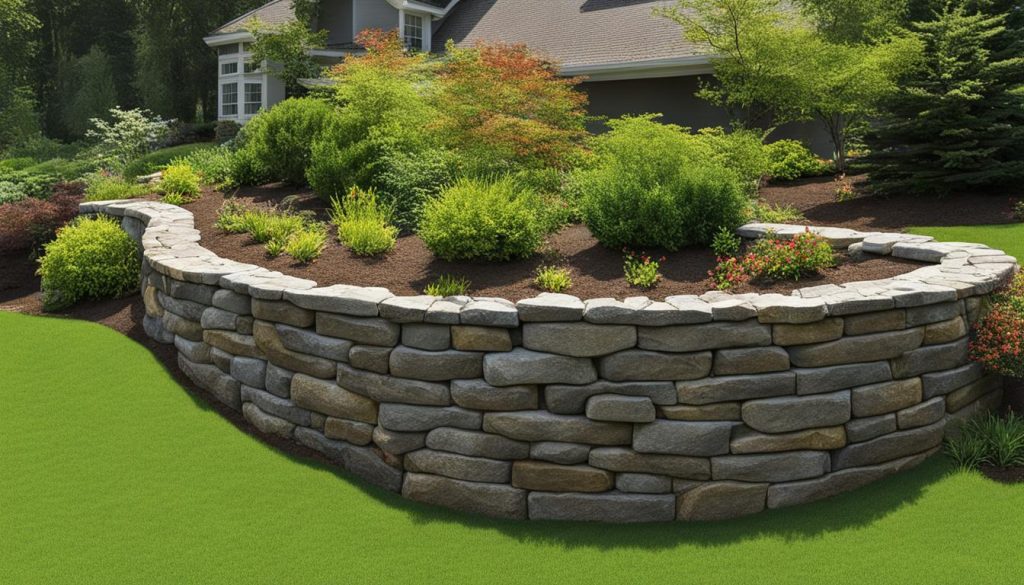Welcome, homeowners! Retaining walls serve as essential components of your property, maintaining a level ground and preventing soil erosion. To ensure their longevity and stability, regular maintenance is required. In this section, we’ll provide you with a comprehensive checklist for retaining wall maintenance. Follow these tips to keep your retaining walls in excellent condition for years to come.
Key Takeaways:
- Regular maintenance is necessary to keep your retaining walls functioning correctly.
- Inspect your wall regularly for signs of damage, including cracks, bulging, and leaning.
- Clear vegetation and debris accumulation around your wall to prevent potential damage.
- Proper drainage is critical to prevent water accumulation around your wall.
- Consider hiring professionals for expert retaining wall maintenance services.
Understanding Retaining Walls
Before we dive into the retaining wall maintenance checklist, let’s first discuss what retaining walls are and their purpose in the structure of your home. A retaining wall is a structure that holds soil behind it to prevent erosion and maintain ground levels. They are often used in landscaping to create different elevations and add visual interest to the design.
Retaining walls can be made from various materials, including concrete, masonry, and wood. They can also be segmented or continuous and have varying heights and thicknesses depending on their intended use and the amount of soil they need to retain.
However, as with any structural element, retaining walls are subject to deterioration over time. The elements, soil pressure, and lack of proper maintenance can all contribute to the eventual failure of a retaining wall. Therefore, it’s crucial to understand the common signs of retaining wall deterioration to ensure their longevity and stability.
Common Signs of Retaining Wall Deterioration
| Signs of Retaining Wall Deterioration | Description |
|---|---|
| Cracks | Visible cracks that affect the wall’s stability |
| Bulging | The wall appears to be leaning or bulging outward |
| Excessive Water | Water accumulation behind the wall or at its base |
| Soil Erosion | Loss of soil from behind the wall or at its base |
| Tilting | The wall is tilting or rotating on its base |
If you observe any of these signs of deterioration in your retaining wall, it’s crucial to address them promptly to avoid further damage and potential safety hazards.
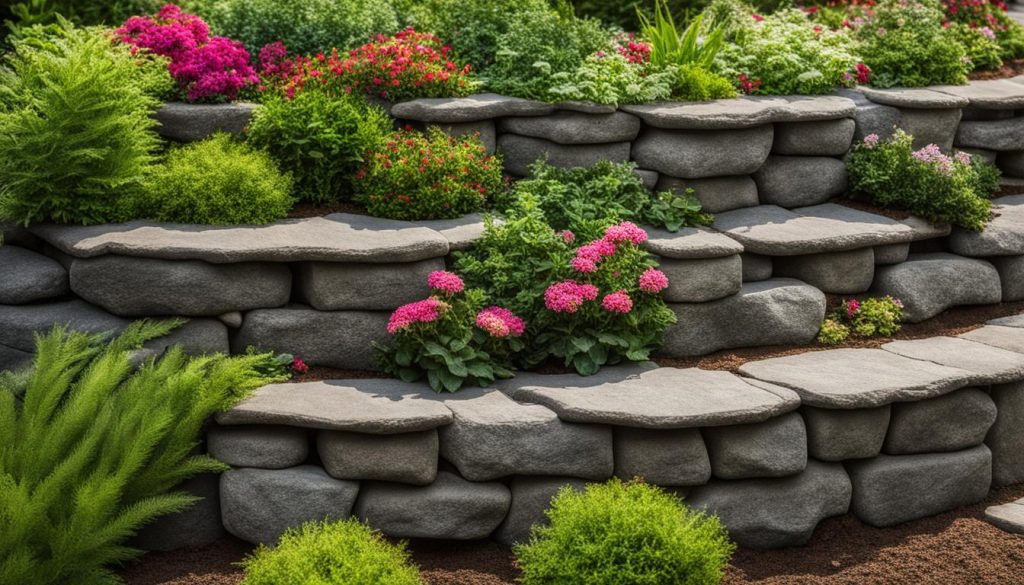
Now that we understand the purpose and common signs of deterioration, let’s move on to the next section: inspecting your retaining wall.
Inspecting Your Retaining Wall
Regularly inspecting your retaining wall is critical in detecting any signs of damage early on. Catching and addressing issues early can prevent them from turning into more severe problems that may require costly repairs. Here are some steps to help you thoroughly inspect your retaining wall:
Step 1: Check for Visible Signs of Damage
Start by examining the retaining wall for any visible signs of damage. Look for cracks, bulges, or leaning. If you notice any of these signs, mark them with a piece of chalk or tape measure and keep a record of their location and size. This information will be helpful when it comes time to make repairs.
Step 2: Look for Water Accumulation
Water accumulation around or behind your retaining wall can cause significant damage. Check for any signs of water pooling, such as soggy soil or puddles. If you notice any water accumulation, it may be an indication of an insufficient drainage system.
Step 3: Inspect the Soil Behind the Wall
The soil behind your retaining wall should be evenly compacted and not loose or eroding. Loose soil can cause the wall to shift or lean, while eroding soil can lead to collapse. If you notice any soil erosion or instability, it’s crucial to address the issue promptly.
Step 4: Check for Vegetation Growth
Vegetation growth can destabilize the retaining wall, so it’s essential to check for any plants or shrubs growing around or behind the wall. Roots from trees or large shrubs can grow into the soil behind the wall, causing it to bulge or shift.
Step 5: Assess the Condition of the Drainage System
The drainage system is critical in ensuring the stability of your retaining wall. Check for any clogs or blockages in the drainage system, and ensure that the water is adequately flowing away from the wall.
Regularly inspecting your retaining wall can help you detect any signs of damage early on. Remember to keep a record of any damage and promptly address any issues to prevent them from turning into more severe problems.
Clearing Vegetation and Debris for Retaining Wall Maintenance
Clearing vegetation and debris from your retaining wall is an essential part of its maintenance and upkeep. Overgrown plants, fallen leaves, and other debris can cause serious damage to your retaining wall if left unchecked. Here are some tips on how to properly clear vegetation and debris from your retaining wall:
1. Assess the Area
Before clearing any vegetation or debris, it’s essential to assess the area around your retaining wall. Check for any plants or trees that could potentially damage the wall, such as those with large root systems or heavy branches. Make sure to remove these plants completely to prevent any future damage.
2. Trim Overgrown Vegetation
If you have any plants or shrubs growing too close to your retaining wall, it’s important to trim them regularly. Overgrown vegetation can cause pressure and stress on the wall, leading to potential cracks or bulges. Make sure to use proper trimming techniques, cutting back to healthy branch points to prevent further growth.
3. Clear Debris Regularly
Regularly clear any debris that falls onto or around your retaining wall. Debris such as leaves, branches, and rocks can accumulate and put pressure on your wall, leading to potential damage over time. Use a rake or broom to sweep away any debris from the area around your wall.
4. Install Drainage Systems
Installing proper drainage systems around your retaining wall can help prevent water accumulation and debris buildup. French drains or surface grading can divert water away from the wall and create a safe and stable environment for your wall to stand.
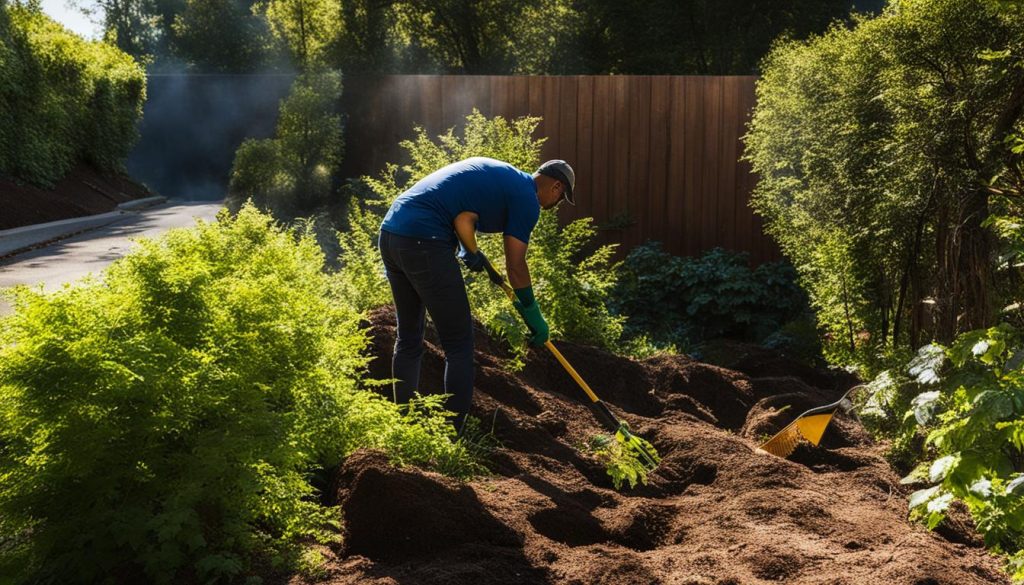
By following these tips and incorporating them into your routine maintenance schedule, you can ensure the longevity and stability of your retaining wall.
Cleaning and Washing Techniques
Regular cleaning and washing of your retaining wall is essential for maintaining its longevity and stability. Here are some effective techniques we recommend:
- Power washing: This method involves using high-pressure water to blast away dirt and stains from your retaining wall. It’s best to avoid using too much pressure as this can damage the wall’s surface. We recommend using a pressure washer with a wide-angle tip and keeping the nozzle at least two feet away from the wall.
- Soap and water: For mild stains and dirt, soap and water can do the trick. Use a soft-bristled brush to gently scrub away the grime and rinse thoroughly with a garden hose.
- Baking soda paste: For tougher stains like rust or oil, mix baking soda with water to form a paste. Apply the paste to the stained area and let it sit for about an hour before scrubbing with a brush and rinsing with water.
Important Note:
When using any of these techniques, avoid using harsh chemicals or abrasive materials as these can damage the surface of your retaining wall.
Additionally, be sure to wear protective eyewear and gloves when handling cleaning solutions or using a pressure washer to avoid any injury.
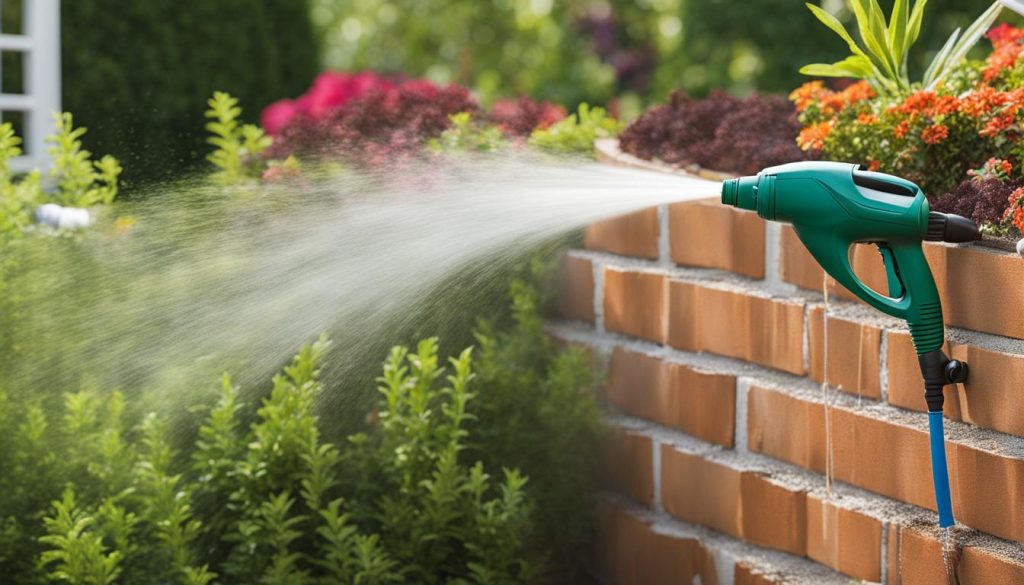
Repairing Cracks and Damage
Cracks and damage to your retaining wall can occur due to various reasons, including moisture buildup, soil movement, and more. Neglected cracks and damage can result in further deterioration and compromise the stability of your wall. In this section, we’ll provide a step-by-step guide on how to repair cracks and damage and prevent future issues.
Step 1: Clean and Prep the Area
Before starting the repair process, ensure that the area around the crack or damage is clean and free of debris. Use a wire brush or chisel to remove any loose particles from the surface. This will help to ensure that the repair material adheres properly.
Step 2: Fill the Cracks or Damage
For minor cracks, you can use a simple concrete patching compound to fill the gap. For larger cracks or damage, you may need to use a concrete mix that contains a bonding agent to ensure the new material properly adheres to the old surface. Be sure to follow the manufacturer’s instructions carefully.
If the damage is severe, you may need to install new blocks or stones in the affected area. This process requires precise measurements and may require the assistance of a professional.
Step 3: Smooth and Finish the Surface
Once the repair material is in place, use a trowel to smooth and level the surface. Be sure to remove any excess material before it dries. You can also add a decorative finish to the surface if desired.
Step 4: Apply a Waterproof Sealant
To provide further protection against moisture and damage, you can apply a waterproofing sealant to the surface of the retaining wall. Be sure to choose a sealant that is compatible with your wall’s material and follow the manufacturer’s instructions carefully.
Regular inspection and maintenance can help prevent cracks and damage to your retaining wall. If you notice any signs of damage, be sure to address them promptly to prevent further deterioration. By following the steps outlined in this section, you can ensure the longevity and stability of your retaining wall for years to come.
Drainage Solutions for Retaining Wall Maintenance
When it comes to maintaining your retaining wall, proper drainage is crucial. Without adequate drainage, water can accumulate around the base of your wall, causing damage and erosion over time. Here are some drainage solutions to keep in mind:
- French drains: A French drain system involves digging a trench around the perimeter of your retaining wall and lining it with gravel and a perforated pipe. This allows water to flow away from the wall and into a designated drainage area.
- Surface grading: If your yard slopes towards your retaining wall, surface grading can help redirect water flow away from the wall and towards a more suitable drainage area.
- Downspout extensions: If your gutters and downspouts deposit water near your retaining wall, installing downspout extensions can help direct the flow of water away from the wall and towards a designated drainage area.
While these solutions can be implemented by homeowners, we recommend consulting with professionals for more complex drainage issues. At Retaining Wall Repair, we offer expert drainage solutions to ensure the longevity and stability of your retaining wall.
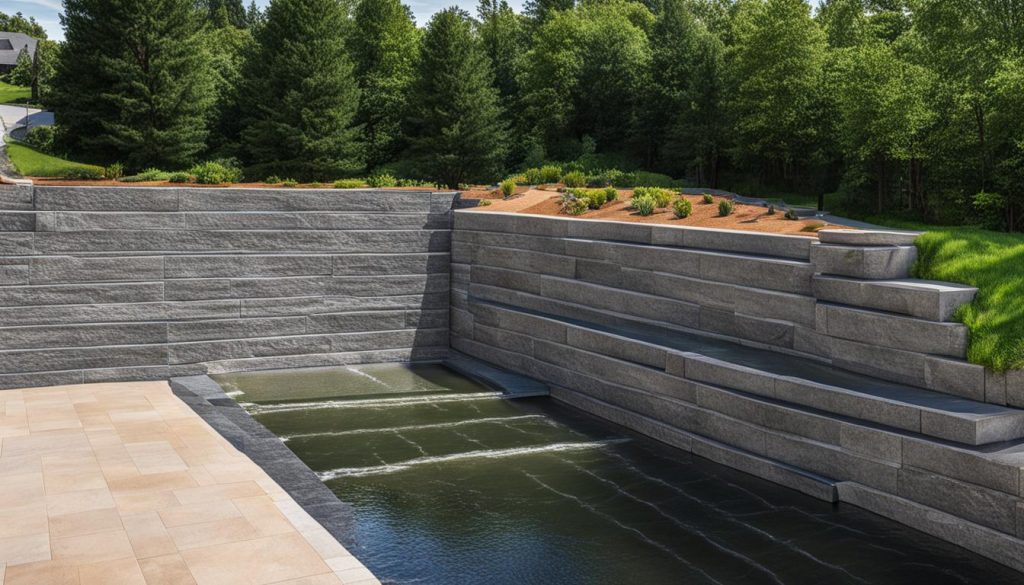
Retaining Wall Protection
Protecting your retaining wall is crucial for ensuring its longevity and stability. Applying sealers and waterproofing products can provide an additional layer of defense against the elements and prevent water penetration, which can cause damage to the wall’s structure over time.
Sealers work by blocking the pores of the retaining wall’s surface, which reduces water absorption. They also protect the wall from stains, dirt, and UV rays, which can cause fading and discoloration. Waterproofing products, on the other hand, provide a more robust barrier against water intrusion and are recommended for retaining walls located in areas with high rainfall or near bodies of water.
Choosing the Right Products
When selecting sealers and waterproofing products for your retaining wall, it’s essential to choose those specifically designed for the material of your wall. Different types of retaining walls require different types of protective measures. For example, concrete walls can be sealed with a water-based acrylic sealer, while natural stone walls require a penetrating sealer that bonds with the surface of the stone.
When it comes to waterproofing products, there are two main types: liquid-applied and sheet membranes. Liquid-applied products are typically spray or brush-on coatings that create a seamless, waterproof barrier over the retaining wall’s surface. Sheet membranes, on the other hand, are thin layers of rubber or PVC that are adhered to the surface of the wall and provide a protective barrier against water intrusion.
The Benefits of Protective Measures
Applying sealers and waterproofing products can extend the lifespan of your retaining wall and reduce the need for costly repairs. They can also prevent the growth of mold and mildew, which can cause health problems and further damage to the wall.
Another benefit of protective measures is that they can enhance the appearance of your retaining wall. Some sealers and waterproofing products come with a glossy or matte finish that can give your wall a fresh, polished look.
Overall, protecting your retaining wall with sealers and waterproofing products is an important part of regular maintenance. By taking proactive measures to defend your wall against the elements, you can ensure that it remains strong, stable, and functional for years to come.
Professional Retaining Wall Maintenance Services
While some homeowners may feel confident in conducting retaining wall maintenance themselves, others may prefer to entrust the care of their retaining walls to professionals. At Retaining Wall Repair, we offer comprehensive retaining wall maintenance services designed to keep your wall in optimal condition for years to come.
Our team of experts has extensive experience in identifying and addressing various issues that can compromise the stability and longevity of your retaining wall. We use state-of-the-art equipment and proven techniques to provide efficient and reliable services that meet your specific needs.
Some of the benefits of hiring our professional maintenance services include:
- Expertise: Our team has the knowledge and skills to spot signs of damage that may not be visible to the untrained eye, ensuring comprehensive and effective maintenance.
- Efficiency: We use specialized tools and methods to conduct maintenance quickly and efficiently, minimizing disruption to your property and daily life.
- Cost-Effectiveness: Regular maintenance can prevent costly repairs and replacements in the future, saving you money in the long run.
- Peace of Mind: With our maintenance services, you can rest assured that your retaining wall is in good hands and will remain structurally sound for years to come.
If you’re looking for professional help with your retaining wall maintenance, don’t hesitate to reach out to us at Retaining Wall Repair. Our friendly and knowledgeable team is here to answer any questions and provide the services you need to keep your retaining wall in top condition.
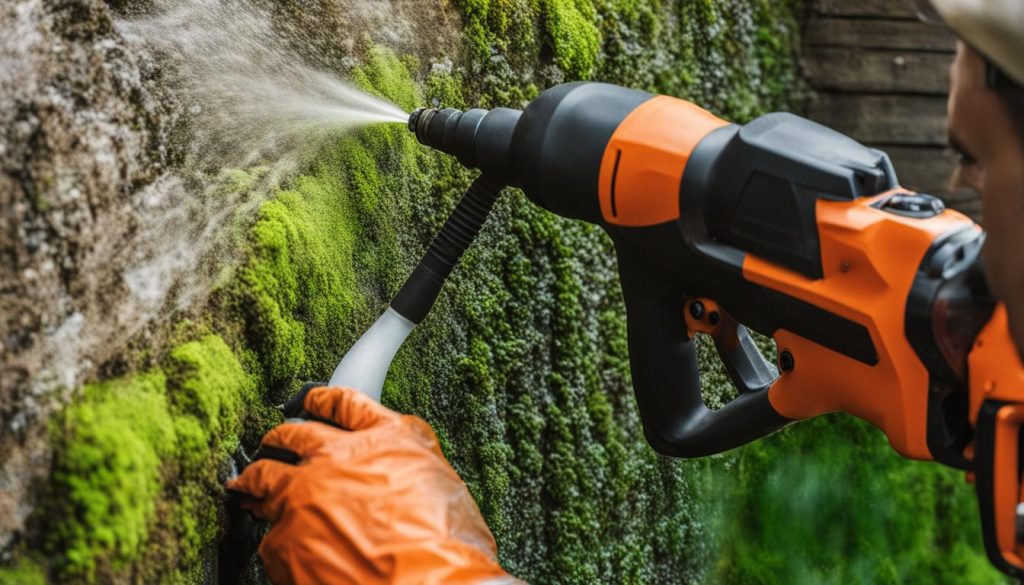
Longevity and Lifespan of Retaining Walls
Regular maintenance is essential for retaining walls to remain functional and stable over time. Without adequate care, the lifespan of a retaining wall can be drastically reduced, leading to potential safety hazards and costly repairs. By following the maintenance checklist we’ve provided and addressing any issues promptly, homeowners can ensure their retaining walls have a long and healthy lifespan.
The longevity of a retaining wall largely depends on its construction, materials used, and local weather conditions. However, a well-maintained retaining wall can last for decades or even longer. With proper inspection, cleaning, repairs, and drainage solutions, retaining walls can withstand the natural forces that cause erosion and deterioration.
Factors that Affect Longevity
Several factors can impact the lifespan of retaining walls. Understanding these factors can help homeowners take proactive measures to prevent damage and prolong the life of their walls. Some of the key factors include:
- Construction quality: Proper construction techniques, appropriate materials, and suitable drainage are essential for a retaining wall’s longevity.
- Soil conditions: The type of soil and its moisture content can affect the stability of a retaining wall. Poor soil conditions can cause settling or shifting, leading to cracks and other types of damage.
- Water management: Retaining walls must be designed to manage water flow effectively and prevent water accumulation behind or around the wall, which can cause pressure and damage over time.
- Maintenance: Regular inspection, cleaning, and repairs are necessary for maintaining the structural integrity of a retaining wall and preventing issues from becoming more severe.
Conclusion
Retaining walls play a crucial role in supporting the landscape and preventing erosion and soil movement. However, they require ongoing care and maintenance to remain effective and safe. By following the checklist we’ve provided and seeking professional help when needed, homeowners can extend the lifespan of their retaining walls and enjoy a beautiful, stable, and safe outdoor environment for years to come.
FAQ
What maintenance tasks should homeowners perform to ensure the longevity of their retaining walls?
Homeowners should regularly inspect their retaining walls for signs of damage, clear vegetation and debris, clean and wash the walls, repair any cracks or damage, implement drainage solutions, consider applying sealers and waterproofing products, and, if needed, seek professional maintenance services.
What are the common signs of deterioration in retaining walls?
Common signs of deterioration in retaining walls include cracks, bulging, leaning, erosion at the base, water accumulation, and excessive vegetation growth.
How often should homeowners inspect their retaining walls?
Homeowners should inspect their retaining walls at least once a year, but it’s recommended to do so more frequently, especially after extreme weather events or if any signs of damage are noticed.
How should I clear vegetation and debris around my retaining wall?
To clear vegetation and debris around your retaining wall, use hand tools such as a shovel or rake to safely remove any plant growth or accumulated debris. Take care not to damage the wall’s structure while clearing the area.
What is the best way to clean a retaining wall?
The best way to clean a retaining wall is to start by removing loose dirt and debris with a broom or brush. For tougher stains, use a mild detergent mixed with water and scrub gently with a soft brush. Rinse the wall thoroughly with clean water afterward.
Can I repair minor cracks in my retaining wall myself?
Minor cracks in retaining walls can often be repaired by homeowners. Use a suitable crack repair product or mortar mix and follow the manufacturer’s instructions. It’s important to monitor for any further damage and consult a professional if the crack worsens or the wall’s stability is compromised.
How can I improve the drainage around my retaining wall?
There are various drainage solutions to improve the drainage around your retaining wall. French drains, surface grading, and proper slope adjustment can help redirect water away from the wall and prevent water accumulation that could weaken the structure.
Should I apply sealers or waterproofing products to my retaining wall?
Applying sealers or waterproofing products to your retaining wall can provide additional protection against moisture and potential damage. Consult with a professional or refer to the manufacturer’s instructions to determine the most suitable product for your specific type of retaining wall.
When should I consider hiring professional retaining wall maintenance services?
Homeowners should consider hiring professional retaining wall maintenance services if they are unsure about the extent of damage, lack the necessary tools or expertise, or need assistance with complex repairs. Our team at Retaining Wall Repair is available to provide expert maintenance services.
How long can retaining walls typically last with proper maintenance?
With proper maintenance, retaining walls can typically last for several decades. Regular inspections, timely repairs, and ongoing care can significantly extend the longevity and lifespan of retaining walls.

